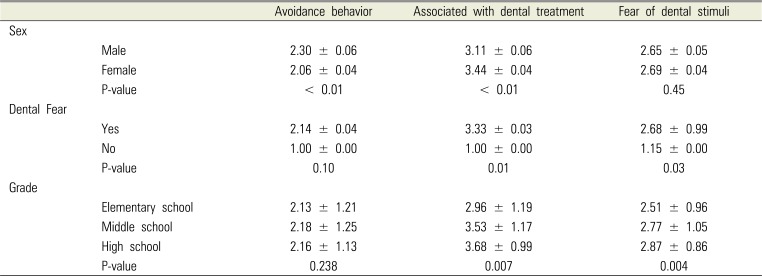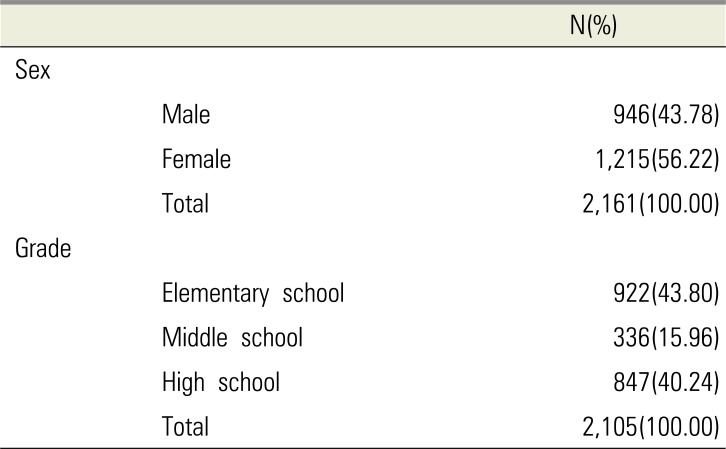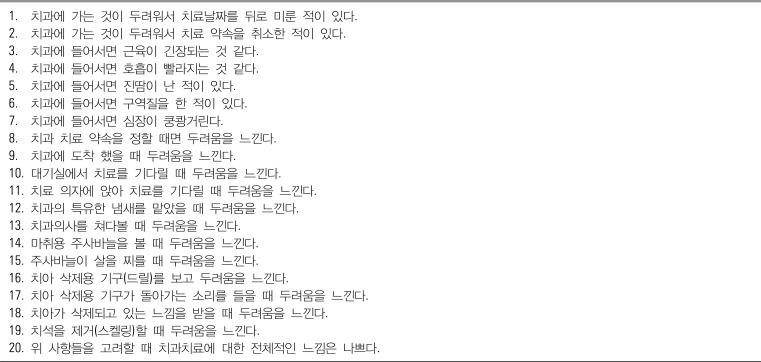1. Textbook of Korean academy of pediatric dentistry. Revision 1st. Seoul: Ehwa publishing;1990. p. 118–125.
2. Kleinknecht RA, Thorndike RM, McGlynn FD, Harkavy J. Factor analysis of the dental fear survey with crossvalidation. J Am Dent Assoc. 1984; 108:59–61. PMID:
6582116.

3. Shim YS, Kim AH, An SY. Dental fear and anxiety of juveniles in some areas of Gyeonggi province. J Korean Acad Pediatr Dent. 2011; 38:362–367.

4. Shim YS, Kim AH, AN SY. Dental Fear and the associated Factors of some Middle School Students in Cheongju-City. J Korea Contents Assoc. 2013; 13:295–304.

5. Kim AH, Shim YS, Park SY, Kim HW, An SY. Reliability and validity of the Korean version of the Dental Fear Survey. J Dent Anesth Pain Med. 2015; 15:85–92. PMID:
28879263.

6. Kim AH, Ahn ES, AN SY. Factors affecting dental fear in Korean adolescents. J Korean Dent Sci. 2017; 10:22–28.
7. Khan MH, Alif SM, Haque S. A review and critical analysis about dental phobia. Bangladesh J Dent Res Edu. 2011; 1:23–26.

8. Locker D, Liddell A, Dempster L, Shapiro D. Age of onset of dental anxiety. J Dent Res. 1999; 78:790–796. PMID:
10096455.

9. Klingberg G, Berggren U, Carlsson SG, Noren JG. Child dental fear: cause-related factors and clinical effects. Eur J Oral Sci. 1995; 103:405–412. PMID:
8747678.

10. Kanegane K, Penha SS, Borsatti MA, Rocha RG. Dental anxiety in an emergency dental service. Rev Saude Publica. 2003; 37:786–792. PMID:
14666310.
11. Vassend O. Anxiety, pain and discomfort associated with dental treatment. Behav Res Ther. 1993; 31:659–666. PMID:
8216168.

13. Kumar S, Bhargav P, Patel A, Bhati M, Balasubramanyam G, Duraiswamy P, et al. Does dental anxiety influence oral health-related quality of life? Observations from a cross-sectional study among adults in Udaipur district. India. J Oral Sci. 2009; 51:245–254. PMID:
19550093.

14. Yousuf A, Ganta S, Nagaraj A, Pareek S, Atri M, Singh K, et al. Acoustic noise levels of dental equipments and its association with fear and annoyance levels among patients attending different dental clinic setups in Jaipur, India. J Clin Diagn Res. 2014; 8:ZC29–ZC34.

15. Siegel K, Schrimshaw EW, Kunzel C, Wolfson NH, Moon-Howard J, Moats HL, et al. Types of dental fear as barriers to dental care among African American adults with oral health symptoms in Harlem. J Health Care Poor Underserved. 2012; 23:1294–1309. PMID:
24212175.

16. Lueken U, Hoyer J, Siegert J, Gloster AT, Wittchen HU. Symptom provocation in dental anxiety using cross-phobic video stimulation. Eur J Oral Sci. 2011; 119:61–68. PMID:
21244513.

17. Sghaireen MG, Zwiri AM, Alzoubi IA, Qodceih SM, Al-Omiri MK. Anxiety due to dental treatment and procedures among university students and its correlation with their gender and field of study. Int J Dent. 2013; 2013:647436. PMID:
23573092.

18. Al-Omari WM, Al-Omiri MK. Dental anxiety among university students and its correlation with their field of study. J Appl Oral Sci. 2009; 17:199–203. PMID:
19466251.

19. Hilton IV1, Stephen S, Barker JC, Weintraub JA. Cultural factors and children's oral health care: a qualitative study of carers of young children. Community Dent Oral Epidemiol. 2007; 35:429–438. PMID:
18039284.

20. Milgrom P, Vignehsa H, Weinstein P. Adolescent dental fear and control: prevalence and theoretical implications. Behav Res Ther. 1992; 30:367–373. PMID:
1616471.









 PDF
PDF ePub
ePub Citation
Citation Print
Print





 XML Download
XML Download